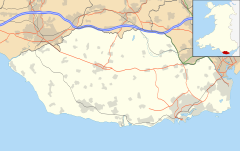Llanblethian
Llanblethian
|
|
|---|---|
 View of Llanblethian looking north towards St John the Baptist Church |
|
| Llanblethian shown within the Vale of Glamorgan | |
| OS grid reference | SS986741 |
| Community | |
| Principal area | |
| Ceremonial county | |
| Country | Wales |
| Sovereign state | United Kingdom |
| Post town | COWBRIDGE |
| Postcode district | CF71 |
| Dialling code | 01446 |
| Police | South Wales |
| Fire | South Wales |
| Ambulance | Welsh |
| EU Parliament | Wales |
| UK Parliament | |
| Welsh Assembly | |
Llanblethian (Welsh: Llanfleiddan) is a village in the Vale of Glamorgan in Wales which sits upon the River Thaw. It makes up part of the community of Cowbridge with Llanblethian, which consists of the village itself, the larger market town of Cowbridge and Aberthin.
Llanblethian first came to prominence as one of the manor lordships created by the Norman lords following the Norman invasion of Wales. It was first ruled by the St. Quentins before being taken over by the Siwards. Under the Norman lordship power in the region shifted from the village to nearby Cowbridge, where manorial affairs were conducted. Llanblethian has several fine large buildings including an early 18th century great house, a 12th-century church dedicated to St John the Baptist and its own castle, a largely ruinous structure but with a fine gatehouse known locally as St Quintins Castle.
Llanblethian takes its name from Saint Bleiddian, a contemporary of Germanus of Auxerre (Welsh: Garmon Sant). Llan is Welsh for church, so the village is the 'church of St Bleddian'. The root of blaidd is a translation of lupus, the wolf.
Evidence of early settlements in the area now known as Llanblethian have been discovered in various locations around the village. To the west of Llanblethian, between Breach and Marlborough farms, tumuli - ancient burial mounds - dating from the Bronze Age have been found. On Llanblethian Hill is the site of Caer Dynnaf, a large Iron Age fort, whose walls and ditches can still be seen.
Although no reliable accounts exist of life in Glamorgan in the first 150 years of Norman rule it is known the manor of Llanblethian existed as one of the twelve "member lordships", large areas of land that Glamorgan was divided up into by the Norman Lord Robert Fitzhamon. Most of these manors, specifically the hilly valley regions were held by subservient local Welsh rulers, but Llanblethian and its neighbor Talyfan were held by Norman feudatories. The first lord of Llanblethian manor was Robert St. Quentin, a powerful Norman knight who held lands in Wiltshire, Dorset, Essex and Yorkshire. The St. Quentin family established a fortification within the village. but in 1233 the family was disposed by Richard Siward the lord of Talyfan. With the lordship passing to the de Clare family, an early keep built by the St Quentin family was fortified further with the addition of a gatehouse and curtain wall.
...
Wikipedia

